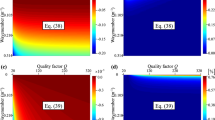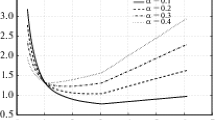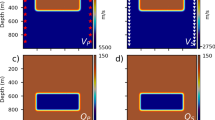Abstract
In recent decades, the study of seismic attenuation has received more and more concerns because it can stimulate the development of wave propagation simulation and improve the accuracy of structure imaging and reservoir prediction. In this paper, we review the attenuation theory and the development of high temporal accuracy wave simulation. The conventional mathematical models to describe the characteristics of viscoelastic are based on constant-Q model or standard linear solids theory. However, these approaches possess some noticeable shortcomings. Therefore, we introduce a frequency-dependent complex velocity to derive the novel viscoelastic wave equations with decoupled amplitude dissipation and phase dispersion. To obtain high temporal accuracy viscoelastic wave simulation, we adopt the normalized pseudo-Laplacian to compensate for the temporal dispersion errors caused by the second-order finite-difference discretization in the time domain. During the implementation, we incorporate the normalized pseudo-Laplacian into the optimized staggered-grid finite-difference coefficients. Therefore, it can greatly reduce the times of low-rank decomposition and Fourier transform and largely improve the computational efficiency. Based on this strategy, we can implement the high temporal accuracy viscoelastic wavefield extrapolation by comprehensively exploiting the staggered-grid finite-difference scheme, pseudo-spectral method and low-rank decomposition algorithm. Meanwhile, a linear velocity model is employed to evaluate the accuracy of low-rank approximation. Furthermore, we use several numerical examples to carry out the comparison between our scheme and other conventional methods. The numerical results reveal that our proposed scheme can effectively compensate for temporal dispersion errors and help generate high temporal accuracy viscoelastic wave solutions.











Similar content being viewed by others
References
Aki K, Richards PG (2002) Quantitative seismology. University Science Books, Herndon
Bai T, Tsvankin I (2016) Time-domain finite-difference modeling for attenuative anisotropic media. Geophysics 81(2):C69–C77
Bai J, Yingst D, Bloor R, Leveille J (2014) Viscoacoustic waveform inversion of velocity structures in the time domain. Geophysics 79(3):R103–R119
Billette FJ, Brandsberg-Dahl S (2005) The 2004 BP velocity benchmark. In: 67th Annual Conference and Exposition, EAGE, Extended Abstracts, B305
Blanch JO, Robertsson JOA, Symes WW (1995) Modeling of a constant Q: methodology and algorithm for an efficient and optimally inexpensive viscoelastic technique. Geophysics 60:176–184
Bohlen T (2002) Parallel 3-D viscoelastic finite difference seismic modelling. Comput Geosci 28:887–899
Carcione JM (2010) A generalization of the Fourier pseudospectral method. Geophysics 75(6):A53–A56
Carcione JM, Kosloff D, Kosloff R (1988) Wave propagation simulation in a linear viscoacoustic medium. Geophys J Int 93:393–401
Carcione JM, Cavallini F, Mainardi F, Hanyga A (2002) Time-domain modeling of constant-Q seismic waves using fractional derivatives. Pure Appl Geophys 159:1719–1736
Chen J (2011) A stability formula for Lax-Wendroff methods with fourth-order in time and general-order in space for the scalar wave equation. Geophysics 76(2):T37–T42
Chen H, Zhou H, Qu S (2014) Lowrank approximation for time domain viscoacoustic wave equation with spatially varying order fractional Laplacians. In: 84th Annual international meeting, SEG, expanded abstracts, pp 3400–3405
Chen H, Zhou H, Li Q, Wang Y (2016) Two efficient modeling schemes for fractional Laplacian viscoacoustic wave equation. Geophysics 81(5):T233–T249
Chen H, Zhou H, Jiang S, Rao Y (2019a) Fractional Laplacian viscoacoustic wave equation low-rank temporal extrapolation. IEEE Access 7:93187–93197
Chen Y, Guo B, Schuster GT (2019b) Migration of viscoacoustic data using acoustic reverse time migration with hybrid deblurring filters. Geophysics 84(3):S127–S136
Chu C, Stoffa P (2011) Application of normalized pseudo-Laplacian to elastic wave modeling on staggered grids. Geophysics 76(5):T113–T121
Crawley S, Brandsberg-Dahl S, McClean J (2010) 3D TTI RTM using the pseudo-analytic method. In: 80th Annual international meeting, SEG, expanded abstracts, pp 3216–3220
Dablain MA (1986) The application of high-order differencing to the scalar wave equation. Geophysics 51(1):54–66
Deng F, McMechan GA (2008) Viscoelastic true-amplitude prestack reverse-time depth migration. Geophysics 73(4):S143–S155
Dutta G, Schuster GT (2014) Attenuation compensation for least-squares reverse time migration using the viscoacoustic-wave equation. Geophysics 79(6):S251–S262
Etgen JT, Brandsberg-Dahl S (2009) The pseudo-analytical method: application of pseudo-Laplacian to acoustic and acoustic anisotropic wave propagation. In: 79th Annual international meeting, SEG, expanded abstracts, pp 2552–2556
Fomel S, Ying L, Song X (2010) Seismic wave extrapolation using low rank approximation. In: 80th Annual international meeting, SEG, expanded abstracts, pp 3092–3096
Fomel S, Ying L, Song X (2013) Seismic wave extrapolation using lowrank symbol approximation. Geophys Prospect 61(3):526–536
Guo P, McMechan GA (2018) Compensating Q effects in viscoelastic media by adjoint-based least-squares reverse time migration. Geophysics 83(2):S151–S172
Guo P, McMechan GA, Guan H (2016) Comparison of two viscoacoustic propagators for Q-compensated reverse time migration. Geophysics 81(5):S281–S297
Holberg O (1987) Computational aspects of the choice of operator and sampling interval for numerical differentiation in large-scale simulation of wave phenomena. Geophys Prospect 35:629–655
Kindelan M, Kamel A, Sguazzero P (1990) On the construction and efficiency of staggered numerical differentiators for the wave equation. Geophysics 55(1):107–110
Kjartansson E (1979) Constant Q-wave propagation and attenuation. J Geophys Res 84(B9):4737–4748
Lax P, Wendroff B (1960) Systems of conservation laws. Commun Pure Appl Math 13(2):217–237
Li Q, Zhou H, Zhang Q, Chen H, Sheng S (2016) Efficient reverse time migration based on fractional Laplacian viscoacoustic wave equation. Geophys J Int 204(1):488–504
Liao Q, McMechan GA (1996) Multifrequency viscoacoustic modeling and inversion. Geophysics 61(5):1371–1378
Liu Y (2014) Optimal staggered-grid finite-difference schemes based on least-squares for wave equation modeling. Geophys J Int 197(2):1033–1047
Liu Y, Sen MK (2009) A new time-space domain high-order finite-difference method for the acoustic wave equation. J Comput Phys 228(23):8779–8806
Liu Y, Sen MK (2013) Time-space domain dispersion-relation-based finite-difference method with arbitrary even-order accuracy for the 2D acoustic wave equation. J Comput Phys 232(1):327–345
Mittet R (2007) A simple design procedure for depth extrapolation operators that compensate for absorption and dispersion. Geophysics 72(2):S105–S112
Ren Z, Li Z (2017) Temporal high-order staggered-grid finite-difference schemes for elastic wave propagation. Geophysics 82(5):T207–T224
Ren Z, Liu Y (2015) Acoustic and elastic modeling by optimal time-space-domain staggered-grid finite-difference schemes. Geophysics 80(1):T17–T40
Robertsson JOA, Blanch JO, Symes WW (1994) Viscoelastic finite-difference modeling. Geophysics 59:1444–1456
Shekar B, Tsvankin I (2011) Estimation of shear-wave interval attenuation from mode-converted data. Geophysics 76(6):D11–D19
Silva NV, Yao G, Warner M (2019) Wave modeling in viscoacoustic media with transverse isotropy. Geophysics 84(1):C41–C56
Song X, Alkhalifah T (2013) Modeling of pseudoacoustic P-waves in orthorhombic media with a low-rank approximation. Geophysics 78(4):C33–C40
Sun J, Zhu T (2018) Strategies for stable attenuation compensation in reverse-time migration. Geophys Prospect 66(3):498–511
Sun J, Zhu T, Fomel S (2015) Viscoacoustic modeling and imaging using low-rank approximation. Geophysics 80(5):A103–A108
Sun J, Fomel S, Zhu T, Hu J (2016) Q-compensated least-squares reverse time migration using low-rank one-step wave extrapolation. Geophysics 81(4):S271–S279
Thomsen L (1986) Weak elastic anisotropy. Geophysics 51:1954–1966
Tsvankin I (2012) Seismic signature and analysis of reflection data in anisotropic media, 3rd edn. Society of Exploration Geophysicists, Houston
Versteeg RJ (1993) Sensitivity of prestack depth migration to the velocity model. Geophysics 58(6):873–882
Wang E, Liu Y, Sen MK (2016) Effective finite-difference modeling methods with 2-D acoustic wave equation using a combination of cross and rhombus stencils. Geophys J Int 206(3):1933–1958
Wang N, Zhou H, Chen H, Xia M, Wang S, Fang J, Sun P (2018) A constant fractional-order viscoelastic wave equation and its numerical simulation scheme. Geophysics 83(1):T39–T48
Wang N, Zhou H, Zhu T (2019) Compensating time-stepping error in fractional Laplacians viscoacoustic wavefield modeling. In: 89th Annual international meeting, SEG, expanded abstracts, pp 3810–3814
Xu S, Liu Y (2018) Pseudoacoustic tilted transversely isotropic modeling with optimal k-space operator-based implicit finite-difference schemes. Geophysics 83(3):1–19
Xu S, Liu Y, Ren Z, Zhou H (2019) Time-space-domain temporal high-order staggered-grid finite-difference schemes by combining orthogonality and pyramid stencils for 3D elastic-wave propagation. Geophysics 84(4):T259–T282
Xue Z, Baek H, Zhang H, Zhao Y, Zhu T, Fomel S (2018) Solving fractional Laplacian viscoelastic wave equations using domain decomposition. In: 88th Annual international meeting, SEG, expanded abstracts, pp 3943–3947
Yan H, Liu Y (2013) Visco-acoustic prestack reverse-time migration based on the time–space domain adaptive high-order finite-difference method. Geophys Prospect 61:941–954
Yan J, Liu H (2016) Modeling of pure acoustic wave in tilted transversely isotropic media using optimized pseudo-differential operators. Geophysics 81(3):T91–T106
Yang J, Zhu H (2018a) A time-domain complex-valued wave equation for modelling visco-acoustic wave propagation. Geophys J Int 215(2):1064–1079
Yang J, Zhu H (2018b) Viscoacoustic reverse time migration using a time-domain complex-valued wave equation. Geophysics 83(6):S505–S519
Yang L, Yan H, Liu H (2015) Optimal rotated staggered-grid finite-difference schemes for elastic wave modeling in TTI media. J Appl Geophys 122:40–52
Yang L, Yan H, Liu H (2017) Optimal staggered-grid finite-difference schemes based on the minimax approximation method with the Remez algorithm. Geophysics 82(1):T27–T42
Zhang J, Yao Z (2013) Optimized explicit finite-difference schemes for spatial derivatives using maximum norm. J Comput Phys 250:511–526
Zhang J, Wu J, Li X (2013) Compensation for absorption and dispersion in prestack migration: an effective Q approach. Geophysics 78(1):S1–S14
Zhang Y, Liu Y, Xu S (2019) High temporal accuracy viscoacoustic wave modeling in vertically transverse isotropic media based on low-rank decomposition. In: 89th Annual international meeting, SEG, expanded abstracts, pp 3790–3794
Zhao X, Zhou H, Wang Y, Chen H, Zhou Z, Sun P, Zhang J (2018) A stable approach for Q-compensated viscoelastic reverse time migration using excitation amplitude imaging condition. Geophysics 83(5):S459–S476
Zhou H, Zhang G (2011) Prefactored optimized compact finite difference schemes for second spatial derivatives. Geophysics 76(5):WB87–WB95
Zhu T, Carcione JM (2014) Theory and modelling of constant-Q P- and S-waves using fractional spatial derivatives. Geophys J Int 196(3):1787–1795
Zhu T, Harris JM (2014) Modeling acoustic wave propagation in heterogeneous attenuating media using decoupled fractional Laplacians. Geophysics 79(3):T105–T116
Zhu Y, Tsvankin I (2006) Plane-wave propagation in attenuative transversely isotropic media. Geophysics 71(2):T17–T30
Zhu T, Carcione JM, Harris JM (2013) Approximating constant-Q seismic propagation in the time domain. Geophys Prospect 61(5):931–940
Zhu T, Harris JM, Biondi B (2014) Q-compensated reverse-time migration. Geophysics 79(3):S77–S87
Acknowledgements
This research is supported by the National Natural Science Foundation of China (NSFC) under contract numbers 41874144 and 41474110 and the Research Foundation of China University of Petroleum-Beijing at Karamay under contract number RCYJ2018A-01-001. Y. Zhang is financially supported by the China Scholarship Council.
Author information
Authors and Affiliations
Corresponding author
Additional information
Publisher's Note
Springer Nature remains neutral with regard to jurisdictional claims in published maps and institutional affiliations.
Appendices
Appendix A. Phase velocity analysis in isotropic media
Substituting plane wave into viscoelastic wave equations can generate the Christoffel equation in attenuative media. This equation is widely used in phase velocity analysis. First, the displacement of a harmonic plane wave in attenuative media can be written as:
where \({\tilde{\mathbf{U}}}\) denotes the polarization vector, \({\tilde{\mathbf{k}}} = {\mathbf{k}}_{R} - i{\mathbf{k}}_{I}\) is the wave vector that becomes complex in the presence of attenuation, \({\mathbf{k}}_{R}\) is the real part of wavenumber and \({\mathbf{k}}_{I}\) is the imaginary part of the wave vector. Substituting the plane wave of Eq. (49) into viscoelastic equations, we can obtain the corresponding Christoffel equation as follows:
where \({\mathbf{G}}\) is the complex Christoffel matrix and \({\mathbf{I}}\) is the identity matrix.
1.1 SH-Wave Phase Velocity Analysis
For the wave vector of SH-wave, the Christoffel equation has the following form (\(\tilde{k} = \left| {{\tilde{\mathbf{k}}}} \right|\)):
Substituting the complex stiffness coefficients \(\tilde{c}_{ij} { = }c_{ij}^{R} + {{i}}c_{ij}^{I}\) into Eq. (51) yields
In weakly attenuative media, we have
Because of the truncated TE of \(\left| {{\omega \mathord{\left/ {\vphantom {\omega {\omega_{0} }}} \right. \kern-0pt} {\omega_{0} }}} \right|^{2\gamma } \approx 1{ + }2\gamma \ln \left| {{\omega \mathord{\left/ {\vphantom {\omega {\omega_{0} }}} \right. \kern-0pt} {\omega_{0} }}} \right|\), the complex moduli are rewritten in the forms
After some simplifications, the imaginary part of Eq. (52) can be formulated as (assume \(\text{sgn} \left( \omega \right) = - 1\)):
The only physically meaningful solution of equation is given by
The real part of Eq. (52) then reduces to
The phase velocity of SH-waves is found as
1.2 P- and SV-Wave Phase Velocity Analysis
For P- and SV-waves, the Christoffel equation can be written as
On the basis of \(\tilde{c}_{ij} { = }c_{ij}^{R} + {{i}}c_{ij}^{I}\) and \({{c_{M,\mu }^{R} } \mathord{\left/ {\vphantom {{c_{M,\mu }^{R} } {c_{M,\mu }^{I} }}} \right. \kern-0pt} {c_{M,\mu }^{I} }}{ = }Q_{P,S} \left( {1{ + }\frac{2}{{\pi Q_{P,S} }}\ln \left| {\frac{\omega }{{\omega_{0} }}} \right|} \right) \approx Q_{P,S} \left| {\frac{\omega }{{\omega_{0} }}} \right|^{{2\gamma_{P,S} }}\), Eq. (60) can be reformulated as
where
The physically meaningful solution of the imaginary part of Eq. (61) is \(\mathcal{K}_{2} { = 0}\), which then yields
After some mathematical manipulations, the real part of Eq. (61) is simplified as follows:
Solving Eq. (64) can obtain the phase velocities in the following form
Based on Eqs. (59) and (65), we can theoretically calculate the P- and S-wave phase velocities.
1.3 Accuracy analysis for
Inserting \(\omega \approx \left| {\mathbf{k}} \right|v_{P0,S0}\) into Eq. (65) produces
Therefore, we can use Eq. (66) to evaluate the accuracy of real phase velocity after adopting the approximation of \(\omega \approx \left| {\mathbf{k}} \right|v_{P0,S0}\). To evaluate quantitatively the accuracy of phase velocity, the relative error is defined as follows:
where RX is the accurate solution and RY is the approximate value.
Based on Eqs. (65) and (66), we calculate the accurate and approximate phase velocities. Figure 11 describes the phase velocity variations with reference velocities, wavenumbers and quality factors. It can be seen that even in a strongly attenuative media (\(Q = 10\)), the phase velocity relative errors are as small as 0.0041. Based on the above analysis, we can conclude that the approximation of \(\omega \approx \left| {\mathbf{k}} \right|v_{P0,S0}\) has a very small influence on phase velocity. Therefore, introducing this approximation to solve viscoelastic wave equations is reasonable.
Appendix B. Phase Velocity Analysis in Anisotropic Media
In this section, we perform SH-, SV- and P-waves phase velocity analysis in VTI attenuative media.
2.1 SH-Wave Phase Velocity Analysis
Based on the complex modulus expression in anisotropic attenuative media (Eq. 41), the real and imaginary stiffness coefficients can be written as (assume \(\text{sgn} \left( \omega \right) = - 1\))
Substituting Eqs. (68) and (69) into Eq. (52), we can derive the following real and imaginary parts, respectively.
Substituting the relationship \(c_{66} = c_{55} \left( {1 + 2\gamma } \right)\) into Eq. (71) and making some simplifications produce
where
The physically meaningful solution of Eq. (72) is
Then, the real part can be simplified as
The phase velocity of SH-wave can be calculated by
where
and
For weakly attenuative media, \(\xi_{Q} \approx 1 { + }\frac{1}{{2\left( {Q_{55} \alpha } \right)^{2} }}.\)
2.2 P- and SV-Wave Phase Velocity Analysis
In VTI attenuative media, Eq. (60) has the following form
Combining Eqs. (68) and (69), Eq. (79) can be simplified as follows:
where
To make Eq. (80) meaningful, we set \(\mathcal{K}_{2}^{ij} { = 0}\), which yields
For weak attenuation (\(k_{R} \gg k_{I}\)), thus we have
Therefore, Eq. (80) can be simplified as follows:
Solving Eq. (84) can obtain the P- or SV-wave phase velocity in VTI attenuative media:
Appendix C. Accuracy Analysis for Incorporating Normalized Pseudo-Laplacian into Optimized SGFD Coefficients
To efficiently solve the new high temporal accuracy viscoelastic wave equations, a critical technology of incorporating normalized pseudo-Laplacian into optimized SGFD coefficients has been proposed. To investigate the accuracy of this operation, we compare the difference between \(\sqrt {\hat{F}\left( {\mathbf{k}} \right)} \sum\nolimits_{m = 1}^{M} {c_{m} \sin \left[ {\left( {m - 0.5} \right)kh} \right]}\) and \(\sum\nolimits_{m = 1}^{M} {c^{\prime}_{m} \sin \left[ {\left( {m - 0.5} \right)kh} \right]}\) with a simple linear velocity model. \(c_{m}\) and \(c^{\prime}_{m}\) stand for the conventional and optimized SGFD coefficients, respectively, computed by Eqs. (28) and (29) through minimizing the square error between the left- and right-hand sides.
First, the velocity and wavenumber are formulated as:
where x is the grid number and N is the grid length. Figure 12 plots some results of \(\sqrt {\hat{F}\left( {\mathbf{k}} \right)} \sum\nolimits_{m = 1}^{M} {c_{m} \sin \left[ {\left( {m - 0.5} \right)kh} \right]}\), \(\sum\nolimits_{m = 1}^{M} {c^{\prime}_{m} \sin \left[ {\left( {m - 0.5} \right)kh} \right]}\) and their differences with different time steps. For a small time step, the differences between two expressions are very small. With the increase in time step, the absolute errors are also growing (Fig. 12a–d). To avoid numerical instability, the spatial interval usually should increase with the time step. Using a large spatial spacing, the approximation errors may decrease a lot (Fig. 12d–f). Overall, the maximal error is relatively small and can be accepted during the computation.
Comparisons between reference (black line) and approximation (red line) computed by \(\sqrt {\hat{F}\left( {\mathbf{k}} \right)} \sum\nolimits_{m = 1}^{M} {c_{m} \sin \left[ {\left( {m - 0.5} \right)k_{x} h} \right]}\) and \(\sum\nolimits_{m = 1}^{M} {c^{\prime}_{m} \sin \left[ {\left( {m - 0.5} \right)k_{x} h} \right]}\) with different time steps and spatial intervals. Note that \(c_{m}\) and \(c^{\prime}_{m}\) stand for the conventional and optimized SGFD coefficients, respectively, which are computed by Eqs. (28) and (29) through minimizing the square error between the left- and right-hand sides
Rights and permissions
About this article
Cite this article
Zhang, Y., Liu, Y. & Xu, S. Viscoelastic Wave Simulation with High Temporal Accuracy Using Frequency-Dependent Complex Velocity. Surv Geophys 42, 97–132 (2021). https://doi.org/10.1007/s10712-020-09607-3
Received:
Accepted:
Published:
Issue Date:
DOI: https://doi.org/10.1007/s10712-020-09607-3






